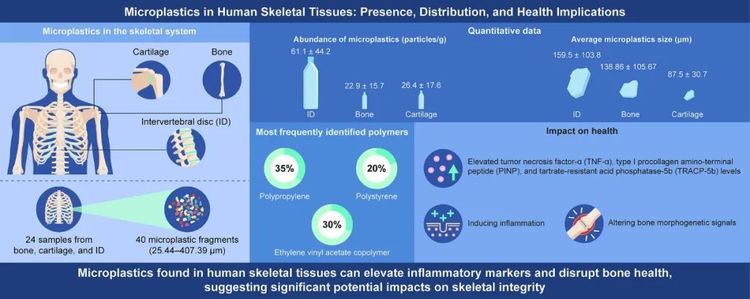Chinese scholars have confirmed that microplastics have invaded human bone tissue.
In recent decades, with the widespread use of plastic products, microplastics have become ubiquitous in the environment. More importantly, an increasing number of studies show that these microplastics can accumulate in the human body, and scientists have found the presence of microplastics in blood, lungs, kidneys, liver, reproductive system, and even the brain.
In real life, microplastics are everywhere, in the air we breathe, bottled water, food packaging, takeout boxes, and so on, leading to our inevitable exposure and ingestion of microplastics. However, the potential risks and impacts of microplastics on human health remain largely unexplained.
Previous studies in animal models have shown that microplastics accelerate the aging of osteoblasts, leading to disorders in endochondral ossification of the growth plate and hindering bone growth during puberty, which has raised concerns about the potential accumulation of microplastics in the skeletal system. However, to date, in vivo data on the presence of microplastics in the human skeletal system are still very limited.
Recently, Xijing Hospital of Air Force Medical University published a research paper titled: Microplastics in human skeletal tissues: Presence, distribution and health implications in the Environment International journal.
The study first confirmed the presence of microplastics in three types of human skeletal tissues (bone, cartilage, and intervertebral disc) and further revealed that the invasion of these microplastics can affect bone health by influencing the expression of inflammatory cytokines and osteogenic cytokines.

Microplastics have been detected in various human tissues, including the gastrointestinal tract, testicular tissue, endometrium, placental tissue, lung tissue, and the brain. Unlike the respiratory system, digestive system, and reproductive system, which are directly exposed to the external environment, the skeletal system is enclosed and does not come into direct contact with environmental microplastics. Therefore, confirming the presence of microplastics in the skeletal system requires extensive research.
The skeletal system differs from other systems in terms of physical, chemical, and biological properties. First, in the human skeletal system, the bone matrix is primarily composed of inorganic salts; while the cartilage matrix mainly contains collagen fibers and water. Contrary to common misconceptions, bones, as the main component of the skeletal system, are relatively active organs, with a renewal rate much faster than that of other body organs. Although bone growth stops after adulthood, the processes of bone formation and resorption continue, maintaining a balance known as bone remodeling.
Therefore, although the content of microplastics in the human body is very low, considering the dynamic renewal process of bone tissue, the potential hazards caused by the long-term or even lifelong accumulation of microplastics in bone tissue are more concerning.
In this new study, the research team characterized for the first time the presence and variation of microplastic deposition patterns in three types of human skeletal tissues (namely, bone, cartilage, and intervertebral disc). Forty microplastic fragments, with diameters ranging from 25.44 to 407.39 micrometers, were observed in 24 human samples from bone, cartilage, and intervertebral disc.
The deposition abundance of microplastics in human intervertebral discs (61.1 ± 44.2 particles/gram) is higher than in bone (22.9 ± 15.7 particles/gram) and cartilage (26.4 ± 17.6 particles/gram). The average size of microplastics in intervertebral discs (159.5 ± 103.8 micrometers) and bone (138.86 ± 105.67 micrometers) is larger than that in cartilage (87.5 ± 30.7 micrometers). The most common types of microplastics are polypropylene (35%), ethylene-vinyl acetate copolymer (30%), and polystyrene (20%).
In vivo experiments showed that after 4 weeks of exposure, microplastics invaded the bones, cartilage, and intervertebral discs through the bloodstream. Compared to the control group, the serum levels of tumor necrosis factor-α (TNF-α), N-terminal propeptide of type I procollagen (PINP), and tartrate-resistant acid phosphatase 5b (TRACP-5b) were elevated in mice exposed to microplastics.
These research findings indicate that microplastics invade the bones, cartilage, and intervertebral discs through the bloodstream, causing a noticeable pattern of microplastic accumulation in these areas. The invasion of these microplastics can affect bone health by influencing the expression of inflammatory cytokines and osteogenic cytokines. These discoveries provide insights into the impact of microplastics on human bone health.
The core findings of the study:
Microplastics accumulate in human intervertebral discs, bones, and cartilage;
The microplastics in bone tissue are mainly polypropylene (PP), polystyrene (PS), and ethylene-vinyl acetate copolymer (EVA);
Microplastics invade bone tissue through the circulatory system;
The invasion of microplastics can affect inflammatory and osteogenic cytokines.

【Copyright and Disclaimer】The above information is collected and organized by PlastMatch. The copyright belongs to the original author. This article is reprinted for the purpose of providing more information, and it does not imply that PlastMatch endorses the views expressed in the article or guarantees its accuracy. If there are any errors in the source attribution or if your legitimate rights have been infringed, please contact us, and we will promptly correct or remove the content. If other media, websites, or individuals use the aforementioned content, they must clearly indicate the original source and origin of the work and assume legal responsibility on their own.
Most Popular
-

List Released! Mexico Announces 50% Tariff On 1,371 China Product Categories
-

Nissan Cuts Production of New Leaf EV in Half Due to Battery Shortage
-

New Breakthrough in Domestic Adiponitrile! Observing the Rise of China's Nylon Industry Chain from Tianchen Qixiang's Production
-

Dow, Wanhua, Huntsman Intensively Raise Prices! Who Controls the Global MDI Prices?
-

Mexico officially imposes tariffs on 1,400 chinese products, with rates up to 50%






